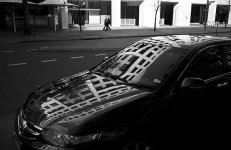That's my interpretation too. I used this approach with the attached shot - metered to ensure the highlights didn't blow out, and let the shadows block up.
But I'm left wondering about how he prints these negs. If he does over-expose then overdevelop, he'll have negs with good shadow detail and very dense highlights. I guess that with the very dense highlights (but apparently not blocked solid) he has to use a long-enough print exposure time that causes the shadows to block up to the extent he wants but without requiring much burning-in. High-contast paper probably helps.
So I wonder how he avoids the highlights blowing out on the neg, with both over-exposure and over-development? When he speaks of over-development, does he mean relative to normal development for the box speed, or relative to the development time that you would normally use for a film pulled (over-exposed) two stops. Let's say he shoots the whole roll of 400 iso film at 100 iso (two stops over-exposure) - does he then develop for the normal 400 iso development time, or does he add 40% to the normal 400 iso development time? (Or does he add 40% to the normal time for a film pulled two stops, and end up developing for the 400 iso normal?)
😀
Just to give you some idea of how much he overdevelops - from Kodak literature that was floating around @ the massive development chart as well as what I have tested, for TRI-X exposed at EI:400 using Rodinal at 1:25 dilution, the development time is between 6:30 and 7 minutes.
So, if Gibson exposes his TRI-X at EI:400, then if he develops for his suggested time of 11 minutes, then he is overdeveloping by 4 minutes. You must also remember that he chooses scenes that have strong highlights a lot of the time, so this overtime if you will of 4 minutes is substantial.
If he exposes his film at EI:100 or 200, then develops at 11 minutes, then he is already overdeveloping his negative by 4 minutes for EI:400, then you have to take into account these extra 1 or 2 stops that he has overexposed. So, instead of pulling and developing for a shorter time than the 7 minutes, he is still overdeveloping regardless. Apparently all of his film receives the same time treatment. Of course he has to print down the highlights, and although the shadows lose their detail when he does this, they still have golf ball like grain - hence the reason for the overexposure.
But as others have mentioned, his 'look' is not only about this gritty development that he achieves, but also how close he gets into the strongly lit subject and breaks down the scene into a few important details, where everything else is left out of the frame. He specifically uses a 50mm summilux for this most of the time as that lens has been his stalwart from day one, namely his early series in LA in the 60's. I enjoy looking at how his vision has developed from his archives on his website.
What is interesting is comparing Gibson with someone like the Magnum photographer Trent Parke, who also achieves big grain, but in contrast, Parke uses the 28mm lens and shoots scenes that have many components in them. They are often more complex in terms of coverage, as there are more elements contained within the one frame.
Gibson's early work was more street related like Parkes and if you look at his Gibson's site there is my favorite shot of the couple walking up from the beach with his shadow also in the scene, insinuating the all seeing eye or the notion of power over his subjects. The grain is also fantastic. In later years he had less elements in his photos.
Anyway, thats my take,
Cheers




